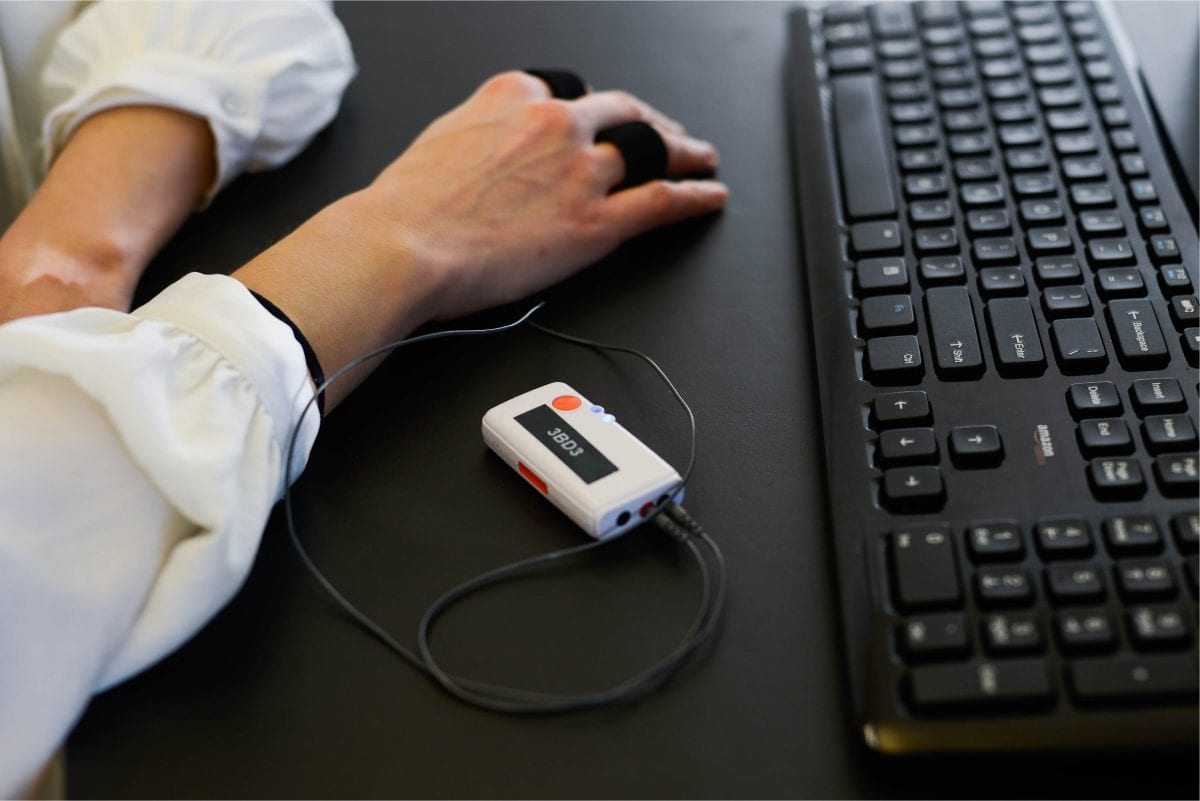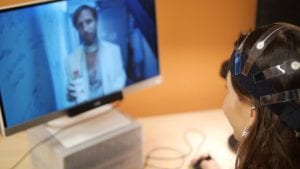Biometric research uncovers subconscious human responses by measuring physiological signals like eye tracking, EEG, and facial expressions. Learn how biometrics provide objective insights into emotions, cognition, and attention, transforming psychology, neuromarketing, and UX research with data-driven precision.
Table of Contents
What is biometric research? While there are many different ways of approaching how biometric research is carried out, there is, fortunately, a single principle to describe it: a method of investigating the subconscious signals from the body, to reveal otherwise hidden features related to emotion, attention, cognition, and physiological arousal.
Let’s go through this in a bit more detail, and unpack that sentence. Biometric research uses sensors that are designed to measure and record various signals that our body produces – from our facial expressions and eye movements, to our heart rate, brain signals, and more.
We subconsciously produce these signals all the time. When we look at a stimulus (such as an image, or an advert), our eyes focus on various features, our facial expression changes, even the minuscule electrical activity generated across our skin can adjust in response (among other physiological changes). All of these signals tell a deep story about how we are feeling in response to a stimulus.

Traditional Methods in Biometric Research: Strengths and Limitations
Traditional methods that have been used to investigate human behavior have often focused on a question-answer approach (be it with surveys, questionnaires, or through simple observation). This approach has garnered a great amount of insight, but has been lacking quantitative and objective data to support (or refute!) the claims made. A lot of trust has been placed on individual answers, and research has shown that this can be all too unreliable.
There are numerous reasons why the question-answer approach has its drawbacks. Such methods are often prone to biases, with respondents unable or even unwilling to speak their mind. This is where biometrics come in. By providing a method to measure the subconscious thoughts and feelings of a respondent, these factors can be quantified, compared, and unbiased conclusions can then be made.
This is part of a paradigm shift within human behavior research (be it within psychology, neuromarketing, or any field that studies human behavior). By using concrete measurements of human physiology, the reliability of findings has never been stronger, and each biometric sensor provides a different and collaborative element in that understanding.

How Bias Impacts Biometric Research and Data Accuracy
An example of the use of biometrics could be as follows: a researcher wants to know how people respond to a new product (but this could be any stimuli really), and they want to have a good idea if it will be a success when it’s released. Within traditional conventions, the respondent would be presented with the product, and asked a series of questions (written or verbally).
The respondent might feel the pressure of the researcher and want to give good answers, or maybe maybe they are feeling the opposite – either way, there are many reasons and factors that could lead to the respondent not giving a reliable answer. The researcher goes away with the results, and like 75% of other product releases, the launch fails.
Consider another scenario: the same test is planned, but instead of using just questionnaires or interviews, the researcher utilizes a biometric approach. The respondent might still be feeling pressured, or unwilling, or unable to consciously discuss their true feelings, yet when they are presented with the product the biometric method of data collection yields something far more reliable.

Eye tracking would show how much time and attention the respondent gave to the product, while facial expression analysis would give an insight into their emotional state, and GSR (galvanic skin response) measurements could then tell you how strongly the emotions were felt. This could also be backed up with measurements of the brain recorded through EEG (electroencephalography), giving information about the feelings of engagement or avoidance that the respondent experienced.
All of the above goes a long way in reliably measuring responses to a product, and when recorded from several participants gives great power to the robustness of the data. By using such data alongside conventional methods (such as interviews), a more complete picture of responses is built up, meaning there’s less chance of being misled by fickle findings.

The Technology Behind Biometric Research
Each sensor provides a new way of looking at human thoughts, emotion, or attention. Below we will go through each of the main biometric sensors that are in use today, and discuss how they inform a greater understanding of human action.
Eye tracking
As the name of this sensor suggests, it is used to track the movement of the eyes. By knowing where someone is looking, and following that throughout time, eye tracking provides a measure of attention – it’s therefore possible to know what someone looked at, if they looked at it at all, for how long, and in which order (among various other measures).
Before any other conclusions are made, it’s important to know if a respondent is even aware of what you are testing them with (did they look at the image, did they watch the video?), so eye tracking provides a crucial measure to check that.

Facial expression analysis
A measurement method that is also conveniently titled, facial expression analysis is a method of quantifying discrete muscular movements of the face, and relating each to an emotional response. As facial expressions are so intimately tied to emotions, the analysis of them is a central approach in understanding an individual’s feelings, throughout time.
Knowing how someone is feeling when presented with a stimulus can provide much-needed information in a variety of contexts, from product and advert testing, to UX design and within psychological experiments.

GSR (Galvanic skin response)
When we experience something physiologically arousing (for example, a roller coaster ride, or an exciting film clip), our skin will literally tingle. Minor fluctuations of electrical activity will occur, and can be detected by GSR devices.
This information is related to the intensity of the reaction to a stimulus, and thus provides a measure of the emotional or physiological intensity, but not what the feeling actually is (that’s where other measures such as facial expression analysis come in).

EEG (Electroencephalography)
The function of the brain is determined by electrically charged signals, that travel from one area to another. EEG works by measuring these electrical changes as they happen en masse. This gives an insight into what the brain is actually doing when an individual encounters a stimulus.
Through tried and tested calculations, summarized metrics have been made available from EEG data – this means that EEG can be used to determine if someone is feeling engaged, distracted, or how hard their brain is working (among other metrics). Being able to know how someone’s brain is implicitly reaction to stimuli can be incredibly insightful.
ECG (Electrocardiography)
It’s perhaps no surprise that your heart rate provides information about how you’re responding to the environment. If we’re anxious or excited then our heart rate will increase, and if we’re drowsy (or asleep!) then our heart rate will decrease. Monitoring the fluctuations between excitation and rest can inform a greater understanding of what is physiologically arousing and what is calming.

The above are some of the most popular biometric sensors that are available, but there are many more methods of measurement that can be utilized. By making the invisible signals that our body generates both visible and measurable, and by combining some – or all – of the above, a thorough, reliable understanding of human behavior can start to take place.
We hope that you now have an clearer understanding of what biometric research is, and how it can be used to quantifiably improve research into human behavior. If you’d like to learn more, then click below to download our free, 52 page guide all about human behavior.
Biometric Research with iMotions
In an age where understanding human behavior is more crucial than ever, biometric research offers a window into the subconscious and emotional responses of individuals. iMotions is at the forefront of this field, providing a comprehensive platform that integrates a variety of biometric technologies to derive deep insights into human reactions and experiences.
What is iMotions?
iMotions is a leading biometric research platform that allows researchers, marketers, and various professionals to gather, analyze, and interpret human physiological and emotional responses. The software integrates a range of biometric sensors and tools in one cohesive environment, offering a multi-faceted view of human behavior.
Key Features of iMotions in Biometric Research:
Sensor Integration: iMotions supports a variety of biometric sensors, including:
- Eye tracking
- Facial expression analysis
- Electroencephalography (EEG)
- Galvanic skin response (GSR)
- Heart rate and heart rate variability
- Electromyography (EMG)
- Unified Platform: With iMotions, researchers can collect data from multiple sensors simultaneously, offering a holistic understanding of participants’ reactions.
Data Visualization: The platform provides advanced data visualization tools, such as heatmaps for eye tracking or time-locked event markers for EEG data, allowing for intuitive analysis and interpretation.
User-Friendly Interface: Despite its advanced capabilities, iMotions offers an intuitive user interface, making it accessible even to those new to biometric research.
Versatile Applications: Whether it’s for academic research, user experience (UX) testing, neuromarketing, or clinical investigations, iMotions offers tools and configurations suitable for various study requirements.
Benefits of Using iMotions in Biometric Research:
Comprehensive Insights: By combining data from multiple sensors, iMotions allows researchers to gain a comprehensive view of human reactions, both cognitive and emotional.
Accuracy: The synchronized multi-sensor data collection ensures high precision and reliability in capturing human responses.
Efficient Workflow: The integrated platform streamlines the research process from study design and data collection to analysis and presentation.
Scalability: iMotions is versatile enough to support both small-scale investigations and large, complex studies with multiple participants.
Frequently Asked Questions: Biometrics in Research and Psychology
Q: What are the concerns with biometric research?
A: Biometric research, while offering invaluable insights, also raises several concerns:
- Privacy: Biometric data is inherently personal. Mishandling or unauthorized access can lead to significant privacy breaches.
- Consent: Participants must be fully informed about the nature of the biometric data being collected and how it will be used. They must provide explicit consent before any data collection takes place.
- Data Storage and Security: Biometric data, given its sensitive nature, requires robust security measures during storage and transmission to prevent unauthorized access or breaches.
- Ethical Considerations: The potential to manipulate or exploit individuals based on insights gained from biometric research, especially in fields like marketing, raises ethical questions.
- Accuracy and Reliability: Like all research methods, biometric tools can have errors. It’s essential to ensure the accuracy and reliability of the devices and methods used.
- Potential for Misinterpretation: Biometric data can be complex. Without proper expertise, there’s a risk of misinterpreting the data, leading to incorrect conclusions.
Q: What are the examples of biometrics in psychology?
A: Biometrics has found diverse applications in psychology, helping researchers delve deeper into human behavior, emotions, and cognitive processes. Some examples include:
Eye Tracking: Used in cognitive psychology and reading research to determine where individuals are looking, how long they fixate on certain points, and the sequence of their gaze. It provides insights into attention, information processing, and even emotional states.
Facial Expression Analysis: Useful in understanding emotional responses. It decodes micro-expressions to determine emotions like happiness, sadness, anger, surprise, etc. This has applications in clinical psychology to understand mood disorders or even in consumer psychology to gauge reactions to advertisements.
Electroencephalography (EEG): Captures brainwave patterns and is used in cognitive neuroscience and psychology to study brain activity linked to various mental states, tasks, or stimuli.
Galvanic Skin Response (GSR): Measures changes in the skin’s electrical conductance, indicating emotional arousal. It’s used in studies related to emotional processing or in clinical settings to understand phobic or anxiety responses.
Heart Rate Variability (HRV): Used to study emotional regulation, stress, and even certain psychological conditions. A lower HRV can be indicative of stress or emotional distress.
Functional Magnetic Resonance Imaging (fMRI): While more associated with neuroscience, it’s used in psychological studies to understand brain regions activated during specific cognitive or emotional tasks.
These biometric tools have expanded the horizons of psychological research, allowing for a deeper, more nuanced understanding of the human mind and behavior.












